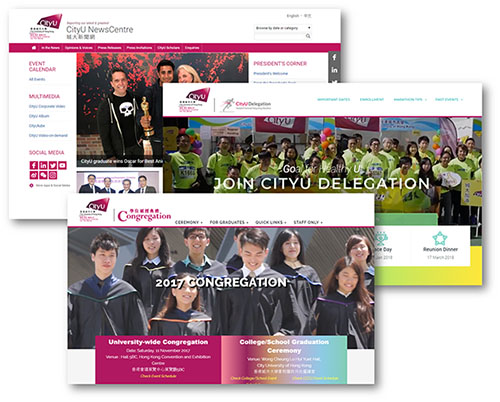Web Content Management – An IT Solution to Decade-long Unresolved Business Problem
by Adams Chan (OCIO)
There could be many reasons to start a web project: a new initiative, a new campaign, a new policy, headship turnover in the department where the websites are designated to; the web masters left the University and therefore lack of support; or when the company supporting the website does not deliver proper level of service.
For CityU’s official website, it was last revamped in 2011 with a primary focus on accessibility and consistent navigation experience on desktop and mobile devices. CityU now has about a few hundred registered websites hosted on the central web servers for around 120 departments. This number excluded those websites hosted by departmental servers. There can easily be over a hundred technologies and workflows adopted for web publication.
What problems are we facing?
This phenomenon created both business and IT problems to CityU. From a business perspective, web content stored and maintained on the web owner’s territory are siloed and may even be outdated - which created fragmented and broken web experience to our web users. Information can also be inconsistent from site to site. From an IT perspective, there are many different methods of maintaining web content; static HTML updating using desktop authoring tools, home-grown or vendor-built content management system, and open-sourced web content management platforms of various kinds and versions.
Institution-wide Web Content Management Platform
With the rapid increase in the number of websites, the technology stack is getting way too complicated and less manageable for up-to-date features and security patches. To resolve this, the Office of the Chief Information Officer (OCIO) has embarked on a project of implementing an institution-wide web content management platform (WCM). With the endorsement from the Information Systems Governance Committee (ISGC), the new platform aims to replace all other legacy web content management platforms in years to come. All new web sites are required to be built on the selected web content management platform.
One interesting counter argument for WCM is that the platform itself is a hacker paradise. While this might be true that WCM is more vulnerable than static HTMLs but the business benefits it brings far exceed the risks. WCM is now something that IT cannot avoid but to embrace and tackle. With a centralised WCM, we are now consolidating our effort to make one single platform be properly run and managed; rather than diluting valuable IT resources to many different solutions.
Which WCM then?
There are many WCMs available in the market. Choosing and implementing the right WCM is a daunting task. While the selection criteria can be different from time to time and from organisation to organisation, the OCIO has decided to choose a WCM that is hosted in the cloud using the Platform-as-a-Service (PaaS) model. One biggest benefit is that we can converge our effort in the integration work rather than architecting the firewalls, load-balancers, operating systems, and hardware servers. The hosting company provides end-to-end services to ensure all components are in place with high service availability; while the CityU team can focus on user experience, information architecting, theme design, and internal governance.
How far did we go?

There are now more than 10 production websites being moved to the new platform including the CityU NewsCentre, CityU Delegation and Congregation websites. The number of sites is expected to ramp up quickly in the next few months as the Central IT has now acquired the necessary skills to fully utilise the system.
One additional benefit which may greatly impact CityU IT development is that the WCM can expose content via API in JSON/XML format easily. In such case, content can be reused more often, which minimises the effort required to maintain content in different channels such as mobile apps and digital signages. The next major challenge would be the University main website revamp, which is scheduled for completion by 2018 Q4. The new website will fundamentally change the way we currently publish our content. Stay tuned for the updates.

There are now more than 10 production websites being moved to the new platform including the CityU NewsCentre, CityU Delegation and Congregation websites. The number of sites is expected to ramp up quickly in the next few months as the Central IT has now acquired the necessary skills to fully utilise the system.
One additional benefit which may greatly impact CityU IT development is that the WCM can expose content via API in JSON/XML format easily. In such case, content can be reused more often, which minimises the effort required to maintain content in different channels such as mobile apps and digital signages. The next major challenge would be the University main website revamp, which is scheduled for completion by 2018 Q4. The new website will fundamentally change the way we currently publish our content. Stay tuned for the updates.